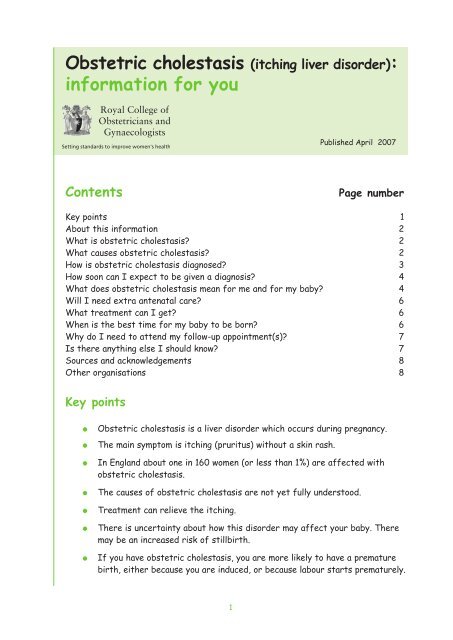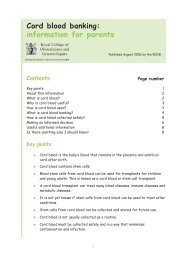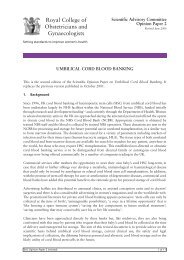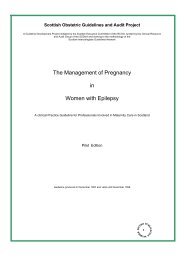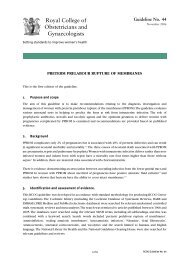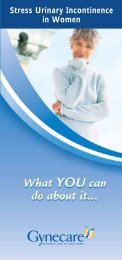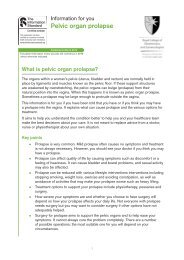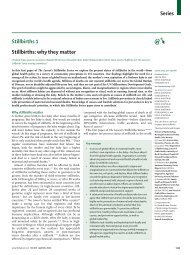Obstetric Cholestasis (Itching liver disorder) - Information for you
Obstetric Cholestasis (Itching liver disorder) - Information for you
Obstetric Cholestasis (Itching liver disorder) - Information for you
Create successful ePaper yourself
Turn your PDF publications into a flip-book with our unique Google optimized e-Paper software.
<strong>Obstetric</strong> cholestasis (itching <strong>liver</strong> <strong>disorder</strong>):in<strong>for</strong>mation <strong>for</strong> <strong>you</strong>Published April 2007ContentsPage numberKey points 1About this in<strong>for</strong>mation 2What is obstetric cholestasis? 2What causes obstetric cholestasis? 2How is obstetric cholestasis diagnosed? 3How soon can I expect to be given a diagnosis? 4What does obstetric cholestasis mean <strong>for</strong> me and <strong>for</strong> my baby? 4Will I need extra antenatal care? 6What treatment can I get? 6When is the best time <strong>for</strong> my baby to be born? 6Why do I need to attend my follow-up appointment(s)? 7Is there anything else I should know? 7Sources and acknowledgements 8Other organisations 8Key points●●●●●●●<strong>Obstetric</strong> cholestasis is a <strong>liver</strong> <strong>disorder</strong> which occurs during pregnancy.The main symptom is itching (pruritus) without a skin rash.In England about one in 160 women (or less than 1%) are affected withobstetric cholestasis.The causes of obstetric cholestasis are not yet fully understood.Treatment can relieve the itching.There is uncertainty about how this <strong>disorder</strong> may affect <strong>you</strong>r baby. Theremay be an increased risk of stillbirth.If <strong>you</strong> have obstetric cholestasis, <strong>you</strong> are more likely to have a prematurebirth, either because <strong>you</strong> are induced, or because labour starts prematurely.1
●●●Other <strong>liver</strong> problems need to be ruled out to make a diagnosis of obstetriccholestasis.<strong>Obstetric</strong> cholestasis gets better after <strong>you</strong>r baby is born.Your healthcare professionals should help <strong>you</strong> in making decisions.About this in<strong>for</strong>mationThis in<strong>for</strong>mation is intended <strong>for</strong> <strong>you</strong> if <strong>you</strong> have been diagnosed with obstetriccholestasis. It is also intended <strong>for</strong> <strong>you</strong> if <strong>you</strong> are pregnant and have persistentitching. It aims to help <strong>you</strong> and <strong>you</strong>r healthcare team make the best decisions about<strong>you</strong>r care. It is not meant to replace discussions with a healthcare professional about<strong>you</strong>r situation.Some of the recommendations here may not apply to <strong>you</strong>. This could be because ofsome other illness <strong>you</strong> have, <strong>you</strong>r general health, or some or all of these things. If <strong>you</strong>think the treatment or care <strong>you</strong> get does not match what we describe here, talk aboutthis with <strong>you</strong>r obstetrician or midwife.What is obstetric cholestasis?(also known as ‘intrahepatic cholestasis of pregnancy’)<strong>Obstetric</strong> cholestasis is a <strong>disorder</strong> that affects <strong>you</strong>r <strong>liver</strong> during pregnancy. The mainsymptom is itching of the skin (pruritus). There is no skin rash. The itching getsbetter when <strong>you</strong>r baby has been born.<strong>Obstetric</strong> cholestasis is uncommon. In England, this <strong>disorder</strong> affects about one in 160women (or less than 1%). <strong>Obstetric</strong> cholestasis is slightly more common among womenof Indian-Asian or Pakistani origin with three in 200 (1.5%) of women affected. InChile and Scandinavia, obstetric cholestasis is more common, with five in 200pregnancies affected (2.5%).What causes obstetric cholestasis?The causes of obstetric cholestasis are not yet understood. It is thought that geneticand environmental factors (<strong>for</strong> example, diet, seasonal variations) may be involved.●HormonesSome doctors believe that pregnancy-related hormones affect the way <strong>you</strong>r<strong>liver</strong> works and cause obstetric cholestasis. Estrogen may influence the waythe <strong>liver</strong> deals with a number of substances, including bile salts.2
Bile is a yellowish fluid that contains waste products and chemicals (known asbile salts). Bile salts usually flow from the <strong>liver</strong> to <strong>you</strong>r gut to help thedigestion of food. In obstetric cholestasis, the flow of bile is reduced. Thiscauses a build-up of bile salts in <strong>you</strong>r body. Some doctors think that it is theeffect of this build-up that causes the itching during pregnancy.One study has suggested that one in five women with obstetric cholestasishave very high levels of bile salts (more than four times higher than normal)and that these women may be more likely to have a premature birth.●Genetic and environmental factors<strong>Obstetric</strong> cholestasis is more common in women from certain ethnic groups,particularly those from South American and Scandinavian regions.Further evidence <strong>for</strong> a genetic component is that obstetric cholestasis runs insome families. If <strong>you</strong> have obstetric cholestasis, there is also a risk ofrecurrence in a future pregnancy. Your healthcare professional will give <strong>you</strong>full in<strong>for</strong>mation (see section Why do I need to attend my follow-upappointment(s)?).How is obstetric cholestasis diagnosed?It is important to check <strong>for</strong> other causes of abnormal <strong>liver</strong> function be<strong>for</strong>e makingthe diagnosis of obstetric cholestasis. You may be offered other tests. What thetests are <strong>for</strong> should be explained to <strong>you</strong>.ConsultationTests do not always involve getting results from a laboratory. Valuable in<strong>for</strong>mation canbe obtained from <strong>you</strong>r family and medical history.Inspection of the skinYour skin will be carefully examined to check that <strong>you</strong>r itching is not related to otherskin conditions, such as eczema. It is possible that <strong>you</strong> may have more than onecondition.Blood testsYou may be offered one or more blood tests <strong>for</strong> obstetric cholestasis. These include:●Liver function test (LFT)A <strong>liver</strong> function test involves a number of laboratory tests that look at howthe <strong>liver</strong> is working. This test is per<strong>for</strong>med on a sample of <strong>you</strong>r blood. Specific<strong>liver</strong> enzymes (proteins that bring about chemical reactions in the body) arechecked.3
●Bile salt testThis measures the level of bile salts in <strong>you</strong>r blood. The bile salt level can beabnormal even if <strong>you</strong>r <strong>liver</strong> function test is normal.●Other blood testsOther tests on <strong>you</strong>r blood will rule out other causes of <strong>liver</strong> problems includingviral hepatitis, Epstein Barr virus, cytomegalovirus, as well as a <strong>liver</strong>autoimmune screen <strong>for</strong> hepatitis and cirrhosis.Ultrasound scanAn ultrasound scan can check <strong>for</strong> <strong>liver</strong> abnormalities and gallstones.Follow-up tests after birth<strong>Obstetric</strong> cholestasis gets better after <strong>you</strong>r baby is born. If <strong>you</strong> continue to haveabnormal <strong>liver</strong> function tests, this may indicate a different problem and <strong>you</strong> should bereferred to a specialist.It is important that <strong>you</strong> attend <strong>you</strong>r follow up appointment(s). See Why do I need toattend my follow-up appointment(s)?.How soon can I expect to be given a diagnosis?For some women with obstetric cholestasis, it can take several weeks after the itchingbegins be<strong>for</strong>e a blood test can detect any problem.If <strong>you</strong> have a normal blood test result (LFT) and <strong>you</strong> are still itching, then <strong>you</strong> shouldbe offered a repeat blood test every other week.What does obstetric cholestasis mean <strong>for</strong> me andmy baby?<strong>Obstetric</strong> cholestasis can be a very uncom<strong>for</strong>table condition but it does not have anyserious consequences <strong>for</strong> <strong>you</strong>r health. The main symptoms are:●<strong>Itching</strong><strong>Itching</strong> can vary from mild to intense and persistent. The itching can start anytime during pregnancy, but it usually starts after 28 weeks.The itching may occur on the palms of <strong>you</strong>r hands and the soles of <strong>you</strong>r feet.It may spread over <strong>you</strong>r arms and legs and, less commonly, may occur on <strong>you</strong>rface, back and breasts. There is no rash.4
Many women have described the itching as constant and, at times, intolerable.Some women scratch so intensely that their skin breaks and bleeds.The itching tends to be worse at night and can disturb sleep, often making <strong>you</strong>feel tired and exhausted during the day.<strong>Obstetric</strong> cholestasis and the itching get better after birth and cause nolong-term health problems.●Other effectsA few women with obstetric cholestasis develop jaundice (yellowing of the skindue to <strong>liver</strong> changes). Some women feel unwell and lose their appetite. Othersigns of obstetric cholestasis are dark urine and pale stools.Further research is needed be<strong>for</strong>e we can be clear about the effects of obstetriccholestasis on the health of <strong>you</strong>r baby.●Thirty years ago, a study from an Australian hospital reported that womenwith obstetric cholestasis had a higher risk of stillbirth than women withoutthis condition. As a result of this study, many women with obstetriccholestasis had actively managed pregnancies, which means that they hadadditional monitoring and were induced early (usually after 37 weeks).●With active management (that is, monitoring and induction of labour at 37 or38 weeks of pregnancy) women with obstetric cholestasis have no greater riskof stillbirth when compared with women without this condition.●What we do not know is whether the reduction in stillbirth rate over the past20 years is due to general improvement in obstetric and neonatal care, generalimprovement in women’s overall health, or the active management ofmonitoring and induction at 37 or 38 weeks of pregnancy.●Women with obstetric cholestasis are more likely to have a preterm birth.This is due partly to induction of labour (one in four women with obstetriccholestasis are induced). There is also an increased risk of going into labourprematurely (one in ten women labour prematurely).●We do not know if it is safe to continue monitoring a woman’s pregnancy andwait <strong>for</strong> natural labour.5
Will I need extra antenatal care?Depending upon <strong>you</strong>r circumstances, <strong>you</strong> may be advised to have additional antenatalchecks to monitor <strong>you</strong>r baby.●Additional monitoring of the baby may include keeping a kick chart, monitoring<strong>you</strong>r baby’s heart rate (cardiotocography) and ultrasounds <strong>for</strong> growth andliquor (fluid) volume. None of these monitoring tests can predict whether aparticular baby is at risk of stillbirth.Your healthcare professional will have a full discussion with <strong>you</strong> so that together <strong>you</strong>can decide what is best <strong>for</strong> <strong>you</strong> and <strong>you</strong>r baby.What treatment can I get?Un<strong>for</strong>tunately, there is no cure <strong>for</strong> obstetric cholestasis except the birth of <strong>you</strong>rbaby.For most women, treatment can only ease symptoms. A choice of treatments isavailable <strong>for</strong> <strong>you</strong>. These might include:●●●skin creams and ointments to relieve the itchingdrugs to reduce the build up of bile salts in the <strong>liver</strong> – ursodeoxycholic acidhelps itching and reduces the level of bile salts. There have only been a fewtrials and it is not licensed <strong>for</strong> treatment in pregnancya daily supplement of vitamin K (water-soluble preparation) – obstetriccholestasis can reduce the absorption of vitamin K from the diet. Vitamin K isneeded to help blood clotting so women with obstetric cholestasis may have anincreased chance of bleeding after birth.Shortly after birth, <strong>you</strong>r baby should be offered vitamin K, as are all babies.When is the best time <strong>for</strong> my baby to be born?There is considerable debate about the best time <strong>for</strong> the baby to be de<strong>liver</strong>ed. Noneof the blood tests is helpful in deciding. If <strong>you</strong> are itching and feeling uncom<strong>for</strong>table,<strong>you</strong> may choose to be induced early. Induction of labour may be offered from 37weeks onwards. Early induction carries an increased chance of caesarean section andan increased chance of <strong>you</strong>r baby being admitted to the special care baby unit becausethey are a few weeks early.Each pregnancy is unique. Your options will be explained so that <strong>you</strong> can make anin<strong>for</strong>med choice.6
Why do I need to attend my follow-upappointment(s)?<strong>Obstetric</strong> cholestasis gets better after birth. The purpose of <strong>you</strong>r follow-upappointment(s) is to ensure that <strong>you</strong>r itching has gone away and <strong>you</strong>r <strong>liver</strong> is workingnormally. The appointment should be at least three weeks after <strong>you</strong>r baby’s birth,because it may take this amount of time to get better. Continuing symptoms andabnormal <strong>liver</strong> function tests suggest a different problem and <strong>you</strong> should be referredto a specialist.At <strong>you</strong>r follow-up appointment(s) <strong>you</strong>r health care professional should:●●●check that the itching has resolvedtake a blood test to check <strong>liver</strong> function to confirm that <strong>you</strong>r <strong>liver</strong> is workingnormallydiscuss the high chance that obstetric cholestasis may happen again in afuture pregnancyIf <strong>you</strong> have had obstetric cholestasis in <strong>you</strong>r pregnancy, it is safe to take theestrogen-containing contraceptive pill if <strong>you</strong>r <strong>liver</strong> function test is normal. If <strong>you</strong> startitching, <strong>you</strong> should speak to <strong>you</strong>r GP or healthcare professional.Is there anything else I should know?●Little is known about how obstetric cholestasis affects a baby’s developmentin the womb. There is no scientific evidence that obstetric cholestasis affects<strong>you</strong>r baby’s growth or causes disability.●Some women have found that having cool baths and wearing loose-fittingcotton clothing helps to reduce the itching.●Drinking alcohol does not cause obstetric cholestasis. However, it is sensible,to avoid alcohol intake when pregnant, especially when there is evidence of any<strong>liver</strong> disease (further in<strong>for</strong>mation can be found on the RCOG website(www.rcog.org.uk) under ‘Alcohol in pregnancy – in<strong>for</strong>mation <strong>for</strong> <strong>you</strong> and <strong>for</strong><strong>you</strong>r baby’).●Some women have found that high stress situations increase itching. Thereare a number of ways <strong>you</strong> can alleviate stress, including relaxation classes,counselling, support groups and complementary medicine. You should discuss<strong>you</strong>r choice with <strong>you</strong>r healthcare professional.7
Sources and acknowledgementsThis in<strong>for</strong>mation is based on the Royal College of <strong>Obstetric</strong>ians and Gynaecologists’(RCOG) guideline on obstetric cholestasis (which was published in January 2006 and isdue to reviewed in January 2009). This in<strong>for</strong>mation will also be reviewed, and updatedif necessary, once the guideline has been reviewed. The guideline contains a full list ofthe sources of evidence we have used. You can find it online at: http://www.rcog.org.uk/resources/Public/pdf/obstetric_cholestasis43.pdf.Clinical guidelines are intended to improve care <strong>for</strong> patients. They are drawn up byteams of medical professionals and consumer representatives who look at the bestresearch evidence available and make recommendations based on this evidence.This in<strong>for</strong>mation has been developed by the Patient <strong>In<strong>for</strong>mation</strong> Subgroup of theRCOG Guidelines and Audit Committee, with input from the Consumers’ Forum and thedevelopers of the clinical guideline. It was reviewed be<strong>for</strong>e publication by womenattending clinics in London and Essex. The final version is the responsibility of theRCOG Guidelines and Audit Committee.Other organisations<strong>Obstetric</strong> <strong>Cholestasis</strong> Support and <strong>In<strong>for</strong>mation</strong> LineWebsite: www.ocsupport.org.ukEmail: JennyChambersOC@aol.comThe British Liver Trust2 Southampton RoadRingwood BH24 1HYTel: 0870 770 8028Website: www.british<strong>liver</strong>trust.org.ukEmail: info@british<strong>liver</strong>trust.org.ukA FINAL NOTEThe Royal College of <strong>Obstetric</strong>ians and Gynaecologists produces patient in<strong>for</strong>mation <strong>for</strong> the public. Thisis based on guidelines which present recognised methods and techniques of clinical practice, based onpublished evidence. The ultimate judgement regarding a particular clinical procedure or treatment planmust be made by the doctor or other attendant in the light of the clinical data presented and thediagnostic and treatment options available.© Royal College of <strong>Obstetric</strong>ians and Gynaecologists 20078


